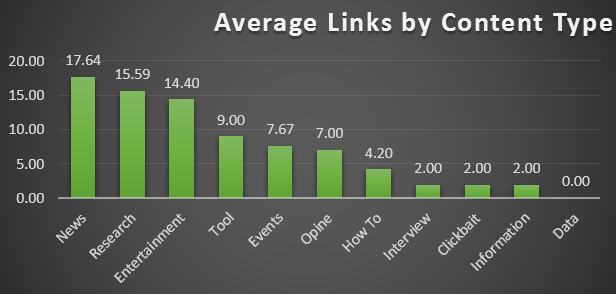Content could increase rankings, even without links.
Personalisation affects rankings, and there is strong evidence that click through rate does too. Content can play a role in influencing both of these, and yet there is still a fixation on links.
One of the most common challenges I face with clients is the pigeonholing of SEO into a narrow set of tasks. In the eyes of many clients, SEO is all about rankings, and good rankings need links. Right?
Yes, links do affect rankings, but if you’ve had any exposure to the industry since April 24, 2012 you might appreciate what an engaging website can achieve.
There’s much more to content than obtaining links, and there is much more to obtaining links than developing content.
SEO attracts many with its mysterious powers. But in a world where links are as much the problem as the solution. Click through rate and personalisation could be the answer.
There’s much more to Obtaining Links than Just Content
I used to read stories on SEOMoz of infographics that marketers would create. I’d gaze in awe at Open Site Explorer and the thousands of links they’d attracted, as if by some dark magic.
Now I understand the realities of our content ridden, penguin infested time. People have more content than they know what to do with. They’re on Facebook, Twitter and Instagram; not in online forums and for the most part, not writing their own blogs. So good quality links are not easy to come by.
There is a misconception that all content is capable of attracting links. In reality, certain types of content are more likely to attract links than others and these can vary by site. For dejanmarketing.com we found that news, research and entertainment content attracted the most links. “How To” or guide type content, which people are often advised to create, attracted few links by comparison.

There are some disclaimers for this data. I excluded commercial and general purpose pages. I also excluded staff profile pages, which in some cases attracted many links, because the popularity of the individual is more important than the content on the page.
Dejan is in the fortunate position of attracting links with relative ease as a result of brand authority. So where we might get two organic links on average for interviews or informational content, others may get none. Where you have limited brand recognition or authority, and produce content on a tight budget, you’ll want to work with content that has the greatest potential to achieve your objectives. For Dejan this would mean developing news, research and entertainment type content. It’s likely that this type of content would work well for websites in a range of industries due to the inherently unique and / or emotive nature.
In short, if you want to create content to organically attract links, you’ll need to develop research, news or entertainment based content. Links are a poor KPI for other types of content. If you are looking for traffic, engagement and conversions, then you can develop a broader range of content that achieves meaningful marketing objectives. Links are only ever a means to an end, not an end in themselves.
There’s much more to Content than Obtaining Links
Content marketing has been around in one form or another since 1897, so links are certainly not the only benefit. A great way of understanding the different objectives of content is using the framework suggested by Edmund Pelgen. This divides content into it’s different purposes:
- Conversions
- Trust and Authority
- Link Attraction
But for some, if content isn’t getting links, it’s not working. Well, content can also help rankings through other means. This may seem like dark magic from the mysterious early days of SEO; but to those in the know, it’s the inevitable outcome of Google’s evolution.
Increased Click Through Rate Increases Rankings
Bing confirmed they use CTR as a ranking factor in 2010, whilst Google implied they used it in tests of the algorithm, but not directly as a ranking factor. A test by Rand Fishkin found that by getting his followers to click a particular result, the rankings of the target URL improved. Another test found that using bots to reduce CTR worked as a negative ranking factor on the page and term targeted. There are even rumours of blackhat services now available that creates artificial click throughs.
To me, the weight of evidence, and common sense, would suggest that CTR is a ranking factor for Google.
I know what you’re thinking. “THIS IS AWESOME, LET’S GET CLICKING”. Before you get too excited, I should mention that Google has a patent which outlines a means of detecting manipulation of CTR. There’s no disavow file for that future penalty.
“Click through rate helps but we can’t fake it. So what?”
That’s where developing targetted content comes in. As you probably know, writing optimised articles on the right topics gives you the opportunity to rank for long tail or less competitive search queries. Whilst your startup insurance company might not be ranking for “Car Insurance” there’s a good chance you can get it to rank for “How can I save on car insurance for my vintage red Ferrari”.
Having a collection of this type of content gives your site an opportunity to rank for a larger number of related terms and have people click through to your result. Current research hasn’t tested the effect of CTR on site wide rankings but it’s not a huge leap to suggest Google will look at the performance of the whole site when ranking it for particular terms.
Users See More of the Sites They Like
Since 2009, Google has been personalising results. Sit in any new client meeting and you’re likely to hear the words “Oh, those are personalised results. You need to enter porn mode”.
In an article on Search Engine Land, Danny Sullivan describes it well:
“By watching what you click on in search results, Google can learn that you favour particular sites. For example, if you often search and click on links from Amazon that appear in Google’s results, over time, Google learns that you really like Amazon. In reaction, it gives Amazon a ranking boost. That means you start seeing more Amazon listings, perhaps for searches where Amazon wasn’t showing up before.
The results are custom tailored for each individual. For example, let’s say someone else prefers Barnes & Nobles. Over time, Google learns that person likes Barnes & Noble. They begin to see even more Barnes & Nobles listings, rather than Amazon ones.”
Now this is another OMG moment. At the time of this change, I remember a lot of consternation from SEOs worrying about the ability to monitoring rankings and a “Big Brand Bias”. Both genuine concerns, but focusing on the negative. The positive being: if we can develop enough good quality content that shows in search results for relevant topics, we get a user level preference boost.
Put another way, by creating content which addresses common questions about our product or service, we can appear more often in search results when users are researching a purchase. When they come to buy and have already visited our site 2-3 times, we have a greater chance to show for more competitive search terms.
Content in the Bigger Picture
Whilst this article focuses on the SEO benefits of content, I should be clear that content is part of a much bigger picture. Content is a cross channel resource. It’s a tool you can use to add value to many areas of your digital strategy, none of which work in isolation. Businesses should promote content on social, email and paid amplification channels to reach as big an audience as possible.
So Content Packs Quite a Punch
Ignoring links for a second, and looking only at the effect on CTR and personalised results, it’s clear content can have a powerful effect for SEO. Using links as a KPI for content performance is taking a very limited view. It ignores both the wider benefits of content and fails to understand the complexity of Google and the direction it is going.



